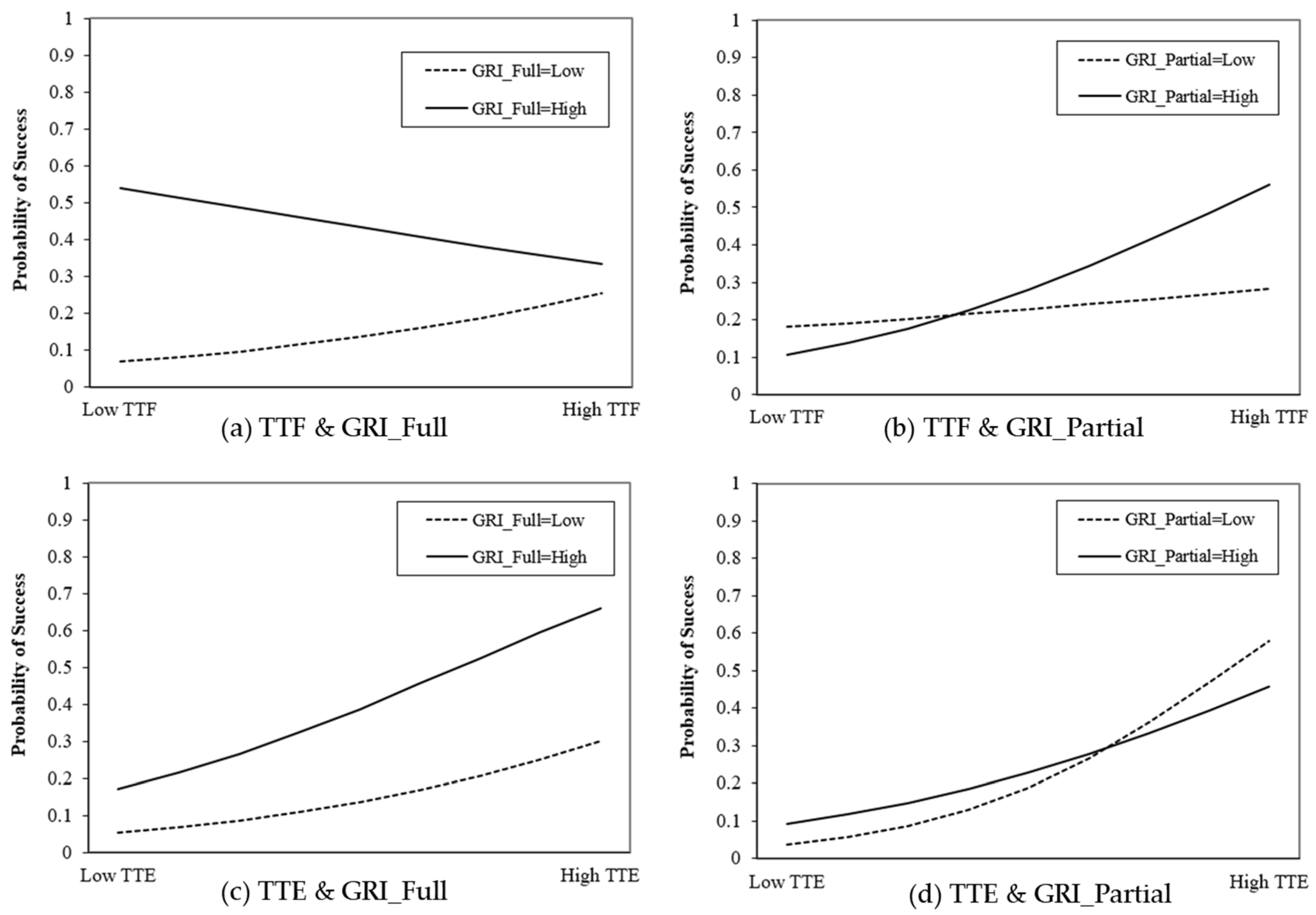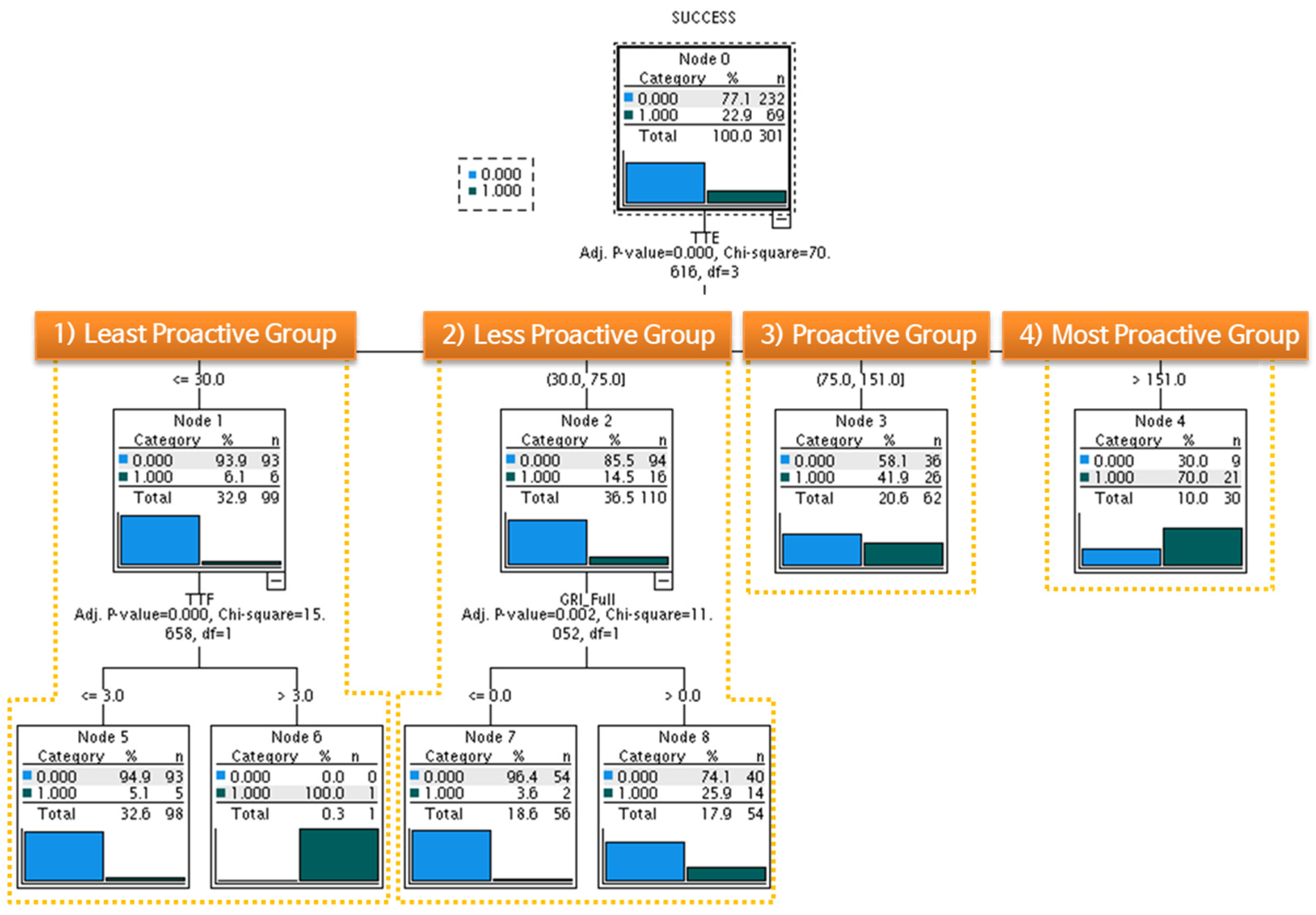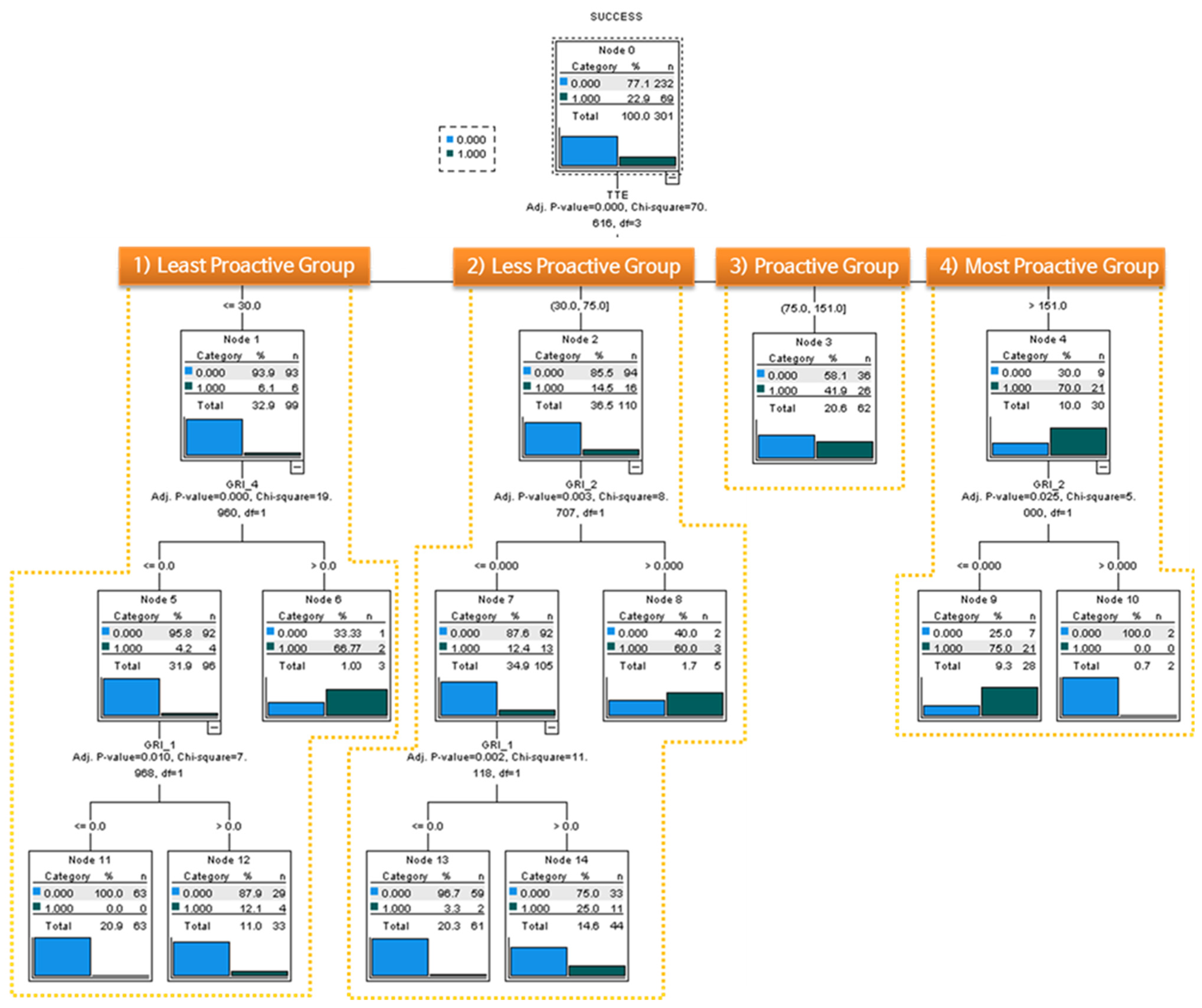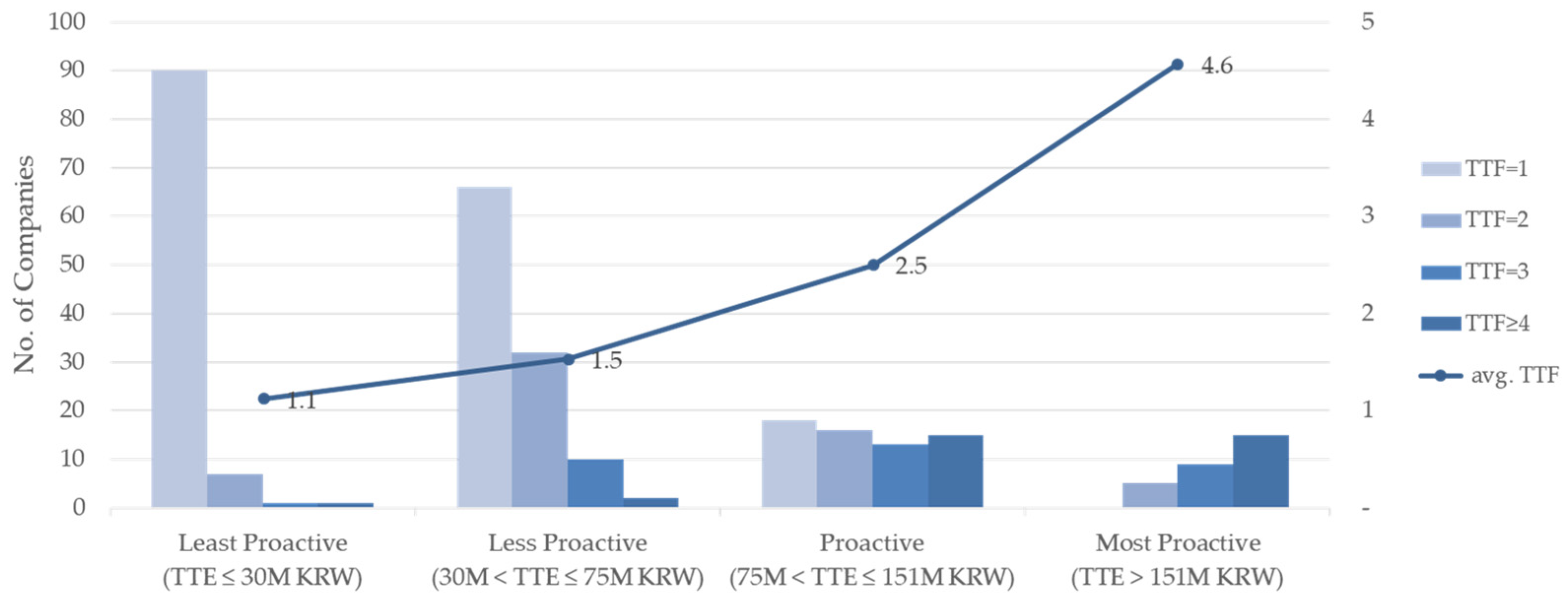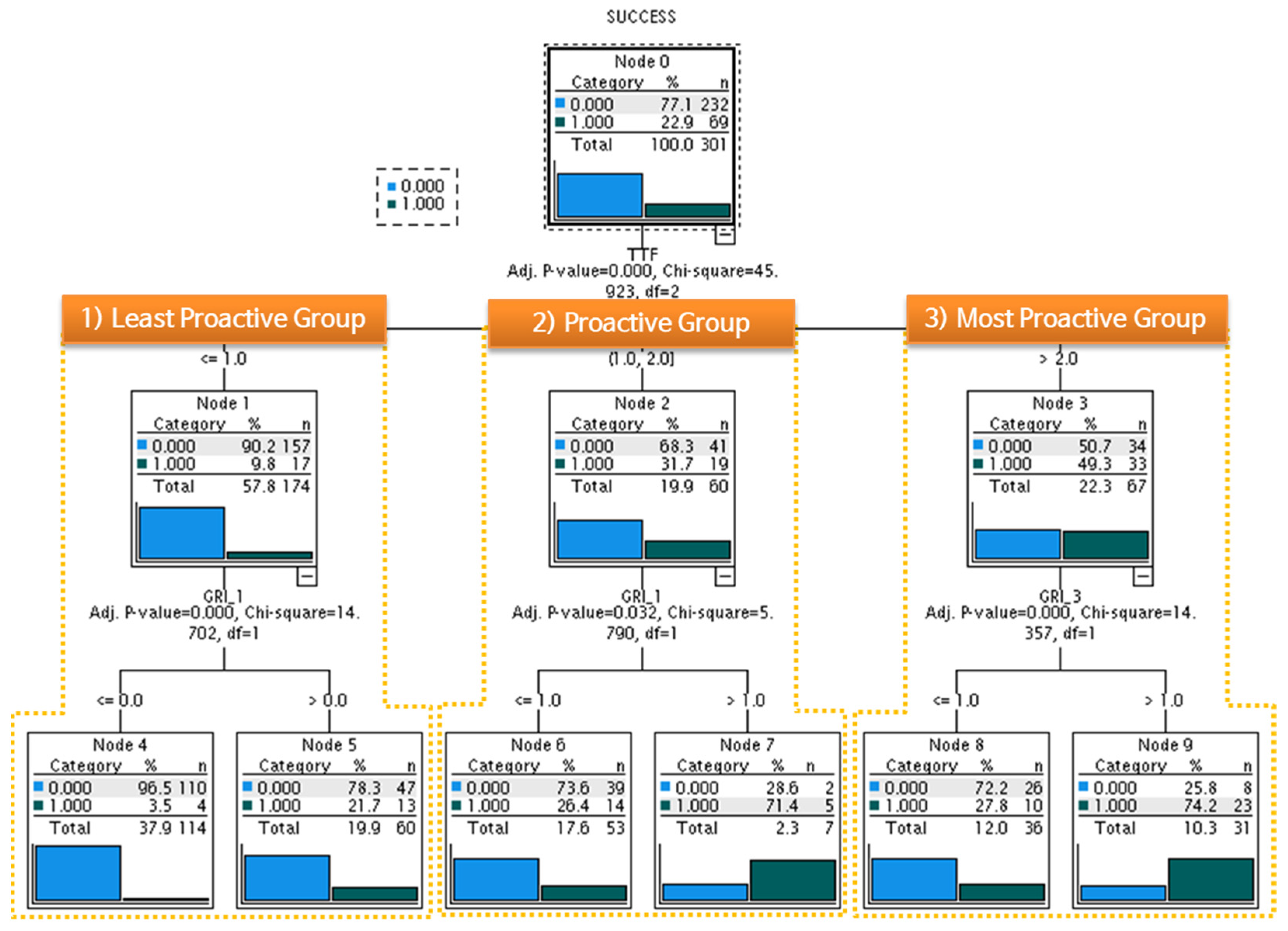1. Introduction
The coronavirus disease 2019 has accelerated the realization of digital transformation [
1,
2,
3]. According to Satya Nadella, Microsoft CEO, “We’ve seen two years of digital transformation in 2 months” [
4]. Technology is changing at a previously unimaginable rate. In the past, the latest technologies were considered the exclusive property of high-tech companies. However, nowadays, it transcends industrial boundaries and has become necessary for every company [
2]. Thus, the continued development of core technologies is essential for the sustainability of companies [
5].
Park and Glenn [
6] have warned that companies failing to adopt accelerating technological changes might go out of business, leading to personal bankruptcy and even a national crisis. In Korea, small- and medium-sized enterprises (SMEs) account for 99.9% of all enterprises and 83.1% of total employment and are closely related to the national economy [
7,
8]. However, these enterprises find it challenging to develop core technologies independently [
9,
10]. Therefore, SMEs must find other ways to reinforce their technological capabilities within a short period of time and escape the crisis [
11,
12].
Public research institutes (PRIs) such as the National Institute of Standards and Technology in the U.S. and the Fraunhofer Society in Germany have played a pivotal role in national R&D activities [
13,
14]. Recently, technology commercialization of R&D results has been emphasized [
15]. Countries around the world have considered public technology transfer as a means to improve the technological competence of companies and have established diverse policies to facilitate the transfer [
16,
17,
18]. However, tangible results are insufficient in the commercialization of public technology despite such efforts [
19,
20]. Existing research tended to focus only on technology transfer from PRIs rather than technology commercialization [
20,
21]. However, since corporate performance is reflected in the national economy, much attention should be paid to increasing the commercialization success rate.
Prior studies have been conducted on the success factors of technology transfer and technology commercialization [
22,
23,
24,
25]. However, in many cases, the concepts of technology transfer and technology commercialization were often confused, and since the examined technology providers were not restricted to PRIs, there was a limitation in that their overall scope was considerably broad. Furthermore, government-funded research institutes (GRIs) and universities were often treated equally as PRIs despite the differences in roles, functions, and competencies of institutions [
26]. Notably, research on the commercialization of technology transferred from GRIs to SMEs is limited [
9].
We aim to identify factors that contribute to the commercialization success of technologies transferred from GRIs to SMEs, set priorities, and quantitatively present their importance. We first focused on the two success factors mentioned most often in previous studies. These are companies’ willingness to commercialize technology [
20,
27,
28,
29,
30] and cooperative partnerships between a technology provider and an adopter [
19,
21,
22,
31,
32]. However, there is another problem in that although the importance of these two factors is recognized, it is difficult to objectively measure them. To solve this problem, we presented novel concepts of SMEs’ and GRIs’ technology commercialization proactiveness (TCP) (hereinafter called SME TCP and GRI TCP, respectively) and then defined their objective measurement indicators.
Hierarchical logistic regression analysis and decision tree analysis were performed on technology transfer cases between SMEs and Electronics and Telecommunications Research Institute (ETRI). ETRI is a leading Korean GRI in terms of the number of quality patents filed, the number of technologies transferred, and diverse support programs [
19,
33,
34]. The commercialization status survey data on SMEs in 2019, ETRI’s internal data, and officially announced company information were used for analysis.
This paper is organized as follows.
Section 1 explains the background and purpose of this study.
Section 2 reviews previous studies on public technology transfer and commercialization and explains the concept of SME TCP and GRI TCP.
Section 3 addresses the research model, data collection method, operational definition of variables, and research methods.
Section 4 discusses the results of the empirical analysis. Finally,
Section 5 presents conclusions and suggestions.
4. Results
4.1. Descriptive Statistics
Table 3 lists the characteristics of the 301 companies. As TTF and TTE increased, the proportion of companies that succeeded in technology commercialization increased significantly. As N_E and N_R increased, the success rate increased slightly. Companies having joint research experience with innovative companies generally had a higher success rate. The relationship between age and commercialization success was unclear. In addition, regardless of the type of support provided by GRI researchers, the greater the amount of support, the higher the success rate of the company. However, the number of SMEs that received support from researchers was not quite high. In particular, only 15 and 20 companies benefited from GRI_2 and GRI_4, respectively.
Table 4 shows descriptive statistics of variables. To satisfy normal distribution criteria of |skewness| < 3 and |kurtosis| < 8 [
84], natural logarithm of N_E, N_R, TTF, and TTE was obtained.
Table 5 presents the results of the correlation analysis of variables. In order to avoid multicollinearity, which could occur in hierarchical regression analysis, the analysis was conducted after the mean centering of continuous variables. Provided that a strong correlation (r = 0.842) between N_E and N_R, N_E was excluded from subsequent analysis. In addition, multicollinearity was not an issue because the variance inflation factor (VIF) was less than 10 [
85].
4.2. Results of the Hierarchical Logistic Regression Analysis
HLRA was conducted to verify the effects of SME TCP and GRI TCP on technology commercialization success. In the first stage, independent variables TTF and TTE were input together with control variables. In the second stage, control variables GRI_Full and GRI_Partial were additionally input. Finally, in the third stage, independent, moderator, and interaction variables were input together.
Table 6 summarizes HLRA results. The logistic regression model was statistically significant in the first stage (Hosmer and Lemeshow: χ
2 = 9.224,
p = 0.324), second stage (Hosmer and Lemeshow: χ
2 = 3.715,
p = 0.882), and third stage (Hosmer and Lemeshow: χ
2 = 2.067,
p = 0.919). Meanwhile, the explanatory power of the regression model was 28.2% (Negelkerke R
2 = 0.282) in the first stage, 34.2% (Negelkerke R
2 = 0.342) in the second stage, and 42.9% (Negelkerke R
2 = 0.429) in the third stage. As variables were input by stage, the value of −2LL gradually decreased to 262.159, 247.067, and 224.099, while Negelkerke R
2 increased. Overall, the goodness of fit of the model was satisfactory.
After verifying the significance of regression coefficients, Ln(TTF) (OR = 2.346, p < 0.01) and Ln(TTE) (OR = 2.486, p < 0.01) were positively significant in Model 1. That is, if Ln(TTF) increased by one unit, the success rate also increased by approximately 2.346 times. Similarly, if Ln(TTE) increased by 1, the success rate also increased by 2.486 times. In Model 2, Ln(TTF) (OR = 1.716, p < 0.1), Ln(TTE) (OR = 2.241, p < 0.01), GRI_Full (OR = 1.747, p < 0.05), and GRI_Partial (OR = 1.383, p < 0.1) were all positively significant. When GRI researchers increased their full involvement by once more, the success rate of technology commercialization increased by 1.747 times. Similarly, when GRI researchers made one more partial involvement, the success rate increased by 1.383 times. Thus, the effects of SME TCP and GRI TCP on technology commercialization success were positive, supporting Hypotheses 1 and 2.
However, in Model 3, Ln(TTF), Ln(TTE), GRI_Full, and GRI_Partial were found to have a positive relationship with commercialization success, whereas the interaction term had both positive and negative effects concurrently. Basically, interaction effects between Ln(TTF) and GRI_Partial (OR = 5.539, p < 0.01) and between Ln(TTE) and GRI_Full (OR = 1.095, p < 0.1) were positive. Conversely, interaction effects between Ln(TTF) and GRI_Full (OR = 0.288, p < 0.05) and between Ln(TTE) and GRI_Partial (OR = 0.363, p < 0.05) were negative. Thus, Hypothesis 3 was partially supported.
Moderating effects can be divided into enhancing, buffering, and interference effects. When an independent variable, moderator variable, and interaction variable have a positive relationship with a dependent variable, an enhancing effect creates synergy between them. Conversely, an interference effect arises when an independent variable and moderator variable have a positive relationship with a dependent variable, whereas an interaction variable and a dependent variable have a negative relationship. Therefore, in this case, the higher the moderator variable, the weaker the influence of an independent variable on a dependent variable [
86]. The nature of the interaction can be confirmed by Dawson’s [
87] slope, as shown in
Figure 2.
Figure 2b,c show the enhancing effects.
Figure 2a,d show interference effects.
Table 7 presents the prediction accuracy of commercialization success based on the HLRA classification table. Specificities (i.e., the rate of predicting failure (0) as failure (0)) were similar at 94.0%, 95.3%, and 93.1% for each model, respectively. Sensitivity (i.e., the rate of predicting success (1) as success (1)) increased by 34.8%, 40.6%, and 49.3%, respectively. Finally, accuracy (i.e., the proportion of prediction identical to the actual category among all data) improved to 80.4%, 82.7%, and 83.1%, respectively, by the analysis stage.
4.3. Results of the Decision Tree Analysis
Figure 3 shows DTA results for Model 4, wherein TTF, TTE, GRI_Full, GRI_Partial, and control variables were input. Variables in the upper nodes have a more crucial influence on the success than in the lower nodes. The most important factor determining the success was TTE. Companies are divided into four groups according to the amount of TTE, with higher TTE implying higher SME TCP. Thus, we named each group as follows: (1) least proactive group, TTE ≤ 30 M KRW; (2) less proactive group, 30 M KRW < TTE ≤ 75 M KRW; (3) proactive group, 75 M KRW < TTE ≤ 151 M KRW; and (4) most proactive group, TTE > 151 M KRW. Success rates for these four groups were 6.1%, 14.5%, 41.9%, and 70.0%, respectively. The higher the SME TCP, the more rapid the improvement of the commercialization success rate. For the least proactive group, TTF was found to be the second most important success factor. In this case, the success rate was meager (i.e., 5.1%) when TTF was less than or equal to three (Node 5). When TTF was more than four (Node 6), the success rate was 100%, but it was difficult to generalize this result because there was only one applicable company. The group most affected by GRI researchers’ support was the less proactive group. Researchers’ full involvement in this group increased the success rate by 7.2 times, from 3.6% (Node 7) to 25.9% (Node 8). Meanwhile, GRI_Partial was not observed in this DTA result.
For the analysis by types of the GRI’s support programs, Model 5 was analyzed. Here, GRI_1, GRI_2, GRI_3, and GRI_4 were used as explanatory variables rather than GRI_Full and GRI_Partial.
Figure 4 shows the results. TTE appeared in the highest node again. The success rate for the least proactive group was 66.7% when GRI_4 was supported (Node 6). It was 12.1% when GRI_1 was supported (Node 12). Considering that the 99 SMEs in the least proactive group had a success rate of 6.1% (Node 1), GRI_4 increased the success rate by 11 times, and GRI_1 doubled the success rate. For the 110 SMEs in the less proactive group, the success rate was 14.5% (Node 2). When supporting GRI_2, the success rate increased by more than four times, up to 60% (Node 8). When supporting GRI_1, the success rate was increased to 25% (Node 14), which was more than 7.5 times higher than that of non-supported companies (Node 13). Success rates of proactive and most proactive groups were 41.9% (Node 3) and 70% (Node 4), respectively. However, as an exceptional example, while the two companies that provided GRI_2 in the most proactive group all failed (Node 10), the success rate of companies without support was high at 75% (Node 9).
In DTA results, TTE was found to be the most critical success factor. In contrast, the effect of TTF was not observed. Therefore, the importance of TTF might have been overlooked. This issue needs to be investigated further. As shown in
Figure 5, TTF increased as TTE increased. The average TTF of groups one, two, three, and four divided by TTE was 1.1, 1.5, 2.5, and 4.6, respectively. Thus, companies with a higher TCP tended to have higher TTE and TTF simultaneously.
Figure 6 illustrates DTA results for Model 6 excluding TTE to examine the effect of TTF. In this case, the TTF was shown at the top node. Companies were divided into three groups based on the degree of TTF, with many TTF implying high SME TCP. Hence, each group was called as follows: (1) least proactive group, TTF = 1, (2) proactive group, TTF = 2, and (3) most proactive group, TTF ≥ 3. As TTF increased, the success rate increased by more than five times, from 9.8% (Node 1) to 49.3% (Node 3). In particular, when GRI_3 was supported twice or more for the most proactive group, the success rate was 74.2% (Node 9), which was the highest value in the decision tree. Meanwhile, when GRI_1 was supported twice or more for the proactive group, the success rate was as high as 71.4% (Node 7).
Table 8 illustrates the prediction accuracy for commercialization success of Models 4, 5, and 6 based on the DTA classification table. Specificities for Models 4, 5, and 6 were 96.1%, 95.7%, and 95.7%, respectively. Sensitivities were 31.9%, 37.7%, and 40.6%, respectively. Compared with the prediction accuracy for Models 1, 2, and 3 of LRA shown in
Table 7, the specificity was slightly higher while the sensitivity was slightly lower. Accuracies were 81.4%, 82.4%, and 83.1% for Models 4, 5, and 6, respectively, similar to LRA results.
4.4. Summary of the Analysis Results
We obtained various analysis results by performing HLRA and DTA.
Table 9 shows the input explanatory variables and analysis method for each of the six research models.
Table 10 summarizes the hypothesis test results. The HLRA verified our hypotheses that both SME TCP and GRI TCP played a positive role in technology commercialization success, and GRI TCP played a partially positive moderating role between SME TCP and technology commercialization success. Therefore, providing GRI researchers’ full involvement to companies that invest heavily in technology transfer and providing GRI researchers’ partial involvement to those who receive technology multiple times are effective methods to increase the success rate.
DTA identified success factors considering the interrelationships among various factors not revealed in the statistical analysis. As a result, the most critical success factor was TTE, and the importance of TTF was confirmed. Companies were classified into four groups according to TTE level and three groups according to TTF degree.
Table 11 shows the effects of GRI researchers’ support programs for each group on the success rate.
5. Conclusions and Suggestions
In order to examine factors that contribute to the successful commercialization of technology from GRIs to SMEs, this study analyzed the case of ETRI in Korea. Several studies in the past demonstrated technology adopters’ willingness and cooperative partnerships as success factors for public technology commercialization. As these factors are abstract and complex to quantify objectively, we proposed a new concept of SME TCP and GRI TCP. We used a company’s TTF and TTE as measurement indicators for SME TCP. GRI TCP was measured by the number of GRI researchers’ support programs to a company after technology transfer.
Results of HLRA confirmed that TTF, TTE, and both full and partial involvement of researchers in the technology commercialization process positively affected technology commercialization success. The moderating effect of GRI TCP on SME TCP and the success of technology commercialization were verified. Therefore, consistently supporting researchers’ partial involvement programs for companies with high TTF and full involvement programs for companies with high TTE is significant.
The result of DTA indicated that SME TCP, especially TTE, was the primary and most crucial success factor. Additionally, further analysis confirmed the importance of both TTF and TTE. In particular, the success rate was higher when TTE exceeded 151 M KRW or TTF was three or more. This implies that the possibility of successful technology commercialization can be raised if SMEs consider GRIs as continuous partners and continue to receive technologies. According to the degree of SME TCP, companies were classified into four groups: the least proactive group, less proactive group, proactive group, and most proactive group. Types and degrees of researchers’ support programs that increased the success rate for each group were also revealed.
Although GRI TCP was also found to be an essential factor, companies should be more proactive than GRIs since the main players in promoting the commercialization of public technology are SMEs, and the role of GRIs is auxiliary. As shown in
Figure 7, as SME TCP increased, the degree of the GRIs’ support increased proportionally. In general, GRI researchers tend to avoid participating in a commercial R&D environment [
19,
39]. However, SME TCP ultimately leads to the active participation of researchers.
The significance of this study is as follows. First, from an academic perspective, this study extended the research on success factors of public technology commercialization by empirically analyzing the case of SMEs and ETRI, which has excellent technology development and technology transfer performance. Second, we proposed new concepts of SME TCP and GRI TCP and made it possible to objectively measure them using TTF, TTE, and the degree of GRI researchers’ support. Third, we used various data, such as actual technology transfer information of companies, ETRI’s SME support history data, a survey result, and the official information of the companies, to secure the objectivity of the research. Fourth, various conclusions obtained through HLRA and DTA in this study provide primary data to policy makers and provide practical implications for both SMEs and GRIs.
Based on the analysis results, we offer three suggestions to promote the commercialization success of technology from GRIs to SMEs. First, SMEs that play a key role must have TCP. The higher the level of SME TCP, the greater the commercialization success rate. Companies with high TTE also had high TTF, indicating that they did not consider technology transfer as a one-time event. Ultimately, what is required in advance is a company’s decision to adopt public technology and cooperate continuously with GRIs. Second, GRI researchers’ support after technology transfer catalyzes an increase in SMEs’ technology commercialization success rate. Thus, a policy that encourages researchers to participate more actively in commercial processes is required. In Korea, due to a project-based system (PBS), researchers encounter difficulties even if they are willing to support companies [
30,
88]. Accordingly, a system that renders the relationship with SMEs sustainable by encouraging GRI researchers to actively participate in the technology commercialization process through PBS improvement and incentive provision is required. Third, the excessive licensing fee is the greatest barrier to SMEs’ public technology commercialization [
89]. In this study, the proactive group’s TTE was more than 75 M KRW. This is equivalent to the labor cost of one or two skilled developers in an SME, which is not an amount that can be easily provided. Therefore, sufficient technology finance support is necessary to encourage companies to participate in public technology commercialization.
Despite these important findings, this study has the following limitations, which need to be addressed in further studies. First, a company’s performance was measured simply as the success or failure of technology commercialization. In order to obtain more meaningful results, research on the impact of technology commercialization on business performance and society should be conducted. Further, the criteria for determining the precise contribution of technology to a company’s financial performance and social development and the related time-series data must be obtained. Second, this study only analyzed cases of specific research institutions in the field of information and communications technology. Thus, its application to all GRIs, in general, may be difficult. The research field and scope of development for the technology being pursued by a GRI may vary significantly. Accordingly, a company’s project field and technological characteristics may differ from those of the companies investigated in this study. Additionally, the content of researchers’ support programs after technology transfer may vary from GRI to GRI. Therefore, in future research, an in-depth analysis that subdivides the characteristics of GRIs, the technical fields, and support programs will be required. Finally, SME TCP was measured only with TTF and TTE. The explanatory power of the research model can be strengthened if various other factors such as additional technology transfers, additional development funds, and employment of research personnel are included.

